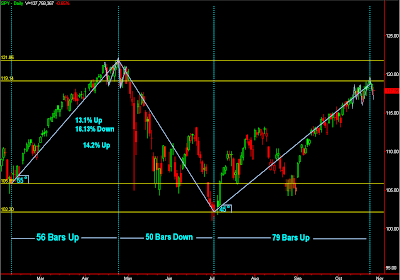~ I have changed the original body of this blog post. ~
I thought I would go over this indicator once again with (hopefully) a clearer explanation and elaborate on some of it's subtleties.
Also,
see this post.
The important stuff:
An indicator can be helpful in the sense that it is not subjective. Where one may think they see a bull flag, an indicator pattern can help you pick up what the eye may not see. However, it shouldn't be a replacement for individual price bars and paying attention to what they may be telling you in the context of the overall mood of the trading environment.
That being said, many useful conditions of the 3/10macd can help you to spot higher probability setups.
If you don't already know, the components of this indicator include a zero line (giving readings above as positive and below as negative), a Fast line (the fast line and the histogram are the same thing; it shows the difference between the 3- & 10-SMA) and a Slow line (16-period average of the difference between the 3- & 10-SMA's).
Start with the Daily:
To keep it simple, you want to see what the 3/10 line (histogram, aka fast line) is doing.
Is it increasing or decreasing?
It's plain as day when the histogram is in a cycling mode, but can lead one into whipsaw when price displays more of a trend behavior. Times like these it may just be easier to go with the question of whether the 3/10 is overall green or red (trending mode or corrective)?
Below, simply the fast line going up shows price moving up and the fast line moving down coinciding with price moving down:

There are some instances (a short squeeze environment in particular) where the 3/10macd fast line is not necessarily indicative of price direction. Just because momentum (this IS a momentum oscillator) is decreasing does NOT mean price "should" be decreasing (in fact, the reason it may be going up is because short sellers keep getting stopped out). So, context is critical.
Now, retaining the Daily chart's information, we can incorporate an intra-day time frame to give us a dual time frame context.
In the 30-min chart below I included a macd histogram that depicts what is happening on the daily chart (top subgraph) while the lower subgraph indicates the regular 30-min 3/10macd.
We are looking at the location and slope of the slow line for a higher time frame direction bias while using the intra-day 3/10 macd as a timing mechanism, but don't forget to take the long-term trend (20- & 50- SMA's) into consideration.
So, in the chart below, the long-term trend (20- & 50-SMA's) is bearish, but the Intermediate trend (higher time frame 3/10macd) is clearly bullish ("bullish" only in the sense that the average smoothed price is increasing for the time being). Being that the "long-term trend" is bearish we can consider a long entry as being "counter-trend" and, therefore, having a shorter holding period.
This is a bigger edit than I was anticipating.....I am going to leave the remainder of this blog post as it is, though it doesn't quite segue well with the information above.
Now what?:
Now you have a direction bias. In this case, the bias is bullish, so one would look for setups that include (but are not limited to) bullish breakouts, pullbacks, fading lows.
Starting with the day in which our histogram went green (6/11) let's dial in to see if any signals were given.
This particular day was range-bound. Following the (long-term) histogram change we got a bullish momentum divergence (on the traded time frame) right at an intra-day support level.
Now let's move to the following day which proved difficult for our bullish bias (as an aside; just because a bias is bullish doesn't mean price won't pull back, retrace, flash-crash, etc.)
We got a late-day run-up in price (momentum) that carried over into this day (bullish so far). Price didn't give up the gap and with our bullish bias we were looking to trade a pullback or breakout, which we got in the morning session. It was at this point that price stalled.
OK, so what happens after momentum in price? Pullbacks (and buyers looking to enter in pullbacks) happen after momentum in price. We just never know how steep the pullback will extend (how interested buyers are).
A couple of things to look at:
Higher intra-day time frame told us momentum kept dropping as price advanced (bearish)
While our trading chart shows us more evidence of lagging prices
Just because we have a bullish bias doesn't mean we can't take a counter-trend trade, like perhaps a First Cross Sell signal (red vertical dash line) as long as we have realistic targets in mind. Also being aware that towards the end of the day both intra-day time frames (5- & 15-min) were showing a bullish momentum divergence (and the next day happened to be a trend-day up, the type of day you need to completely ignore the 3/10 macd).
OK, let's take a look at the next few Bullish Bias days after the trend day up until the bias changed bearish:
Something worth noting; If your bias is bullish and your bullish setups aren't working so well and maybe you see better bearish setups, then price is telling you something.
So, to sum it all up; When using the 3/10 macd we're looking at it's:
Fast line Value - (the color of the histogram; Green = above zero line, Red = below zero line)
Slope - is the fast line (and/or the slow line) increasing or decreasing in value?
Relation of the slow line to the fast line - is the slow line supporting or resisting the fast line?
Well that's all I have for now on this topic, hopefully it was a better explanation of the 3/10 macd than has been provided in the past.


























































